This article explores the precise location of the Amazon Rainforest, its ecological importance, and the ongoing conservation initiatives aimed at safeguarding this extraordinary ecosystem. The Amazon Rainforest is primarily situated in Brazil, although it also extends into Peru, Colombia, and several other South American countries. Spanning over 5.5 million square kilometers, it stands as the world’s largest tropical rainforest.
Key Insights
- The Amazon Rainforest covers more than 5.5 million square kilometers, mainly in Brazil, and is essential for global biodiversity and climate stability.
- Human activities such as agriculture, logging, and urban development have led to considerable deforestation, jeopardizing the rainforest’s ecological balance and exacerbating climate change.
- Conservation efforts—encompassing international policies and the involvement of indigenous communities—are crucial for the Amazon’s preservation, with recent initiatives demonstrating promise in curbing deforestation rates.
The Amazon Rainforest: Geographic Overview
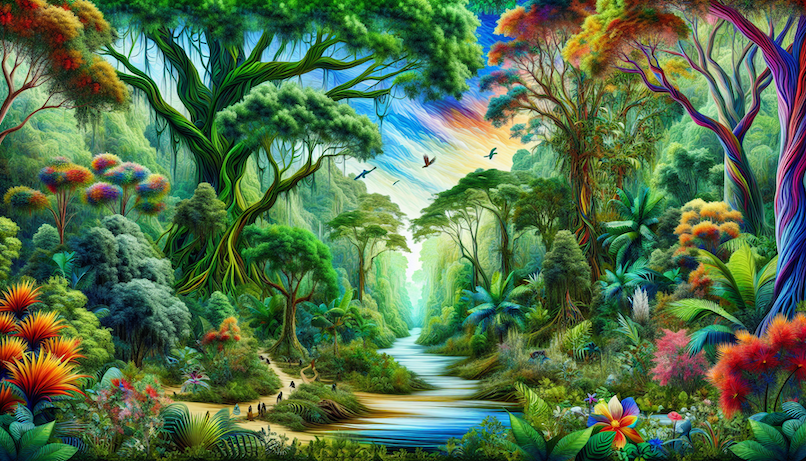
The Amazon Rainforest
The Amazon Rainforest, acknowledged as the largest tropical rainforest globally, covers over 5.5 million square kilometers. While it is primarily located in Brazil, it also extends into Peru, Colombia, and other South American nations. This enormous area encompasses more than half of the planet’s tropical forest, making it indispensable to the global ecosystem. The Amazon River Basin, which spans around 7 million square kilometers, represents approximately 35.5% of the South American continent.
This vast region is distinguished not only by its size but also by its complex network of rivers and waterways. The Amazon River, one of the longest rivers in the world, is crucial to the rainforest’s ecological system. Furthermore, the Atlantic Ocean’s proximity plays a significant role in shaping the Amazon’s climate, contributing to its unique weather patterns.
To fully appreciate the vastness of the Amazon Rainforest, one must examine its geographical extent, the major rivers that sustain it, and the oceans influencing its climate. Collectively, these elements form the foundation of this remarkable natural habitat.
The Amazon Basin’s Extent
The Amazon Basin, a vast area spanning roughly 7 million square kilometers, stretches across nine countries:
- Brazil
- Peru
- Bolivia
- Colombia
- Venezuela
- Guyana
- Suriname
- French Guiana
- Ecuador
This region accounts for around 35.5% of South America, highlighting the Amazon’s significant presence. Notably, the Brazilian Amazon comprises approximately 58.4% of the Amazon Rainforest, underscoring Brazil’s critical role in conserving and managing this essential ecosystem.
The sheer size of the Amazon Basin not only attests to its geographical scale but also to its ecological complexity. This region supports an extraordinary diversity of life forms and ecosystems, making it one of the most biodiverse places on Earth. The Yasuni Reserve in Ecuador serves as a vivid illustration of the rainforest’s bio-richness. The interconnected forests, rivers, and wetlands of the Amazon create a dynamic and resilient environment that has evolved over millions of years.
Major Rivers and Waterways of the Amazon
The Amazon River, which begins in the Andes Mountains, serves as a lifeline for the Amazon Rainforest. Stretching about 6,400 kilometers, it is among the longest rivers worldwide and the largest by water discharge volume. The river is responsible for about 20% of the world’s river flow into the oceans, significantly influencing the global water cycle. Its vast flow and water volume are essential for sustaining the rainforest’s lush and diverse ecosystems.
In addition to the Amazon River, the basin includes major rivers like the Madeira, Negro, and Tapajós. These waterways not only enhance the region’s biodiversity and water dynamics but are also key components of the Amazon’s intricate ecological network, shaping the landscape and providing vital resources to its inhabitants.
Surrounding Oceans
The Amazon Rainforest’s proximity to the Atlantic Ocean is crucial for its climate and weather patterns. Moisture-rich winds from the Atlantic bring substantial rainfall to the area, creating the humid conditions necessary for the lush vegetation of the rainforest. This moisture influx is a primary factor in sustaining the dense forest cover and supporting its diverse ecosystems.
The Atlantic Ocean’s influence goes beyond merely providing rainfall; it also affects temperature and humidity levels within the rainforest, contributing to the overall climate stability of the region. Its position near the Atlantic is a fundamental aspect of the Amazon’s environmental dynamics, shaping the conditions that allow its unique flora and fauna to thrive.
Subscribe to Our Newsletter
Get exclusive access to savings of up to 50%, available only to subscribed members via email.
Historical Formation of the Amazon Rainforest
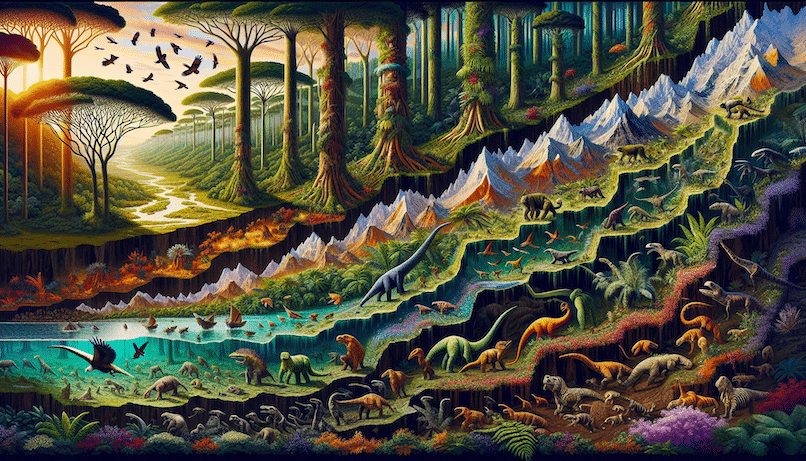

Prehistoric Rainforest
The formation of the Amazon Rainforest is a tale that spans millions of years, molded by geological events and climatic transformations. The disintegration of the supercontinent Gondwana around 184 million years ago set the foundation for the Amazon Basin’s development. It is believed that the Amazon Rainforest began to take shape during the Eocene epoch, roughly 56 to 33.9 million years ago, due to a warm, humid climate.
About ten million years ago, the Amazon River started flowing eastward, carving its current route and further shaping the rainforest. The uplift of the Andes Mountains approximately 25 million years ago also significantly influenced this process, creating a vast basin that eventually became the Amazon River Basin.
These geological and climatic shifts collaboratively contributed to the creation of the rich and diverse ecosystem we observe today.
Geological Evolution of the Amazon Rainforest
The geological evolution of the Amazon Rainforest is marked by major events, including the uplift of the Andes Mountains from tectonic plate collisions around 25 million years ago. This uplift resulted in a large basin that enclosed a significant freshwater lake known as the Solimes Basin. Over time, this lake drained, giving rise to the Amazon River, which now traverses the basin.
Such geological transformations were instrumental in forming the present-day landscape of the Amazon. The emergence of the river and its surrounding basin created the necessary conditions for developing the dense, biodiverse rainforest we know today. The interplay between tectonic movements and river dynamics has been a crucial force in the Amazon’s geological narrative.
Climate Changes Through the Ages
Climate shifts throughout history have profoundly impacted the Amazon Rainforest. During the ice ages, the rainforest fragmented into isolated patches, a phenomenon that fostered speciation and the enhancement of biodiversity. These climatic changes produced distinct habitats where various species evolved and adapted, contributing to the incredible diversity of life present in the Amazon today.
Past climatic variations have also influenced the rainforest’s composition and distribution. The forested areas’ expansion and contraction caused by changing climatic conditions have shaped the Amazon’s ecological landscape. Understanding these historical climate shifts offers insight into the resilience and adaptability of the Amazon’s ecosystems.
Unique Biodiversity of the Amazon Rainforest
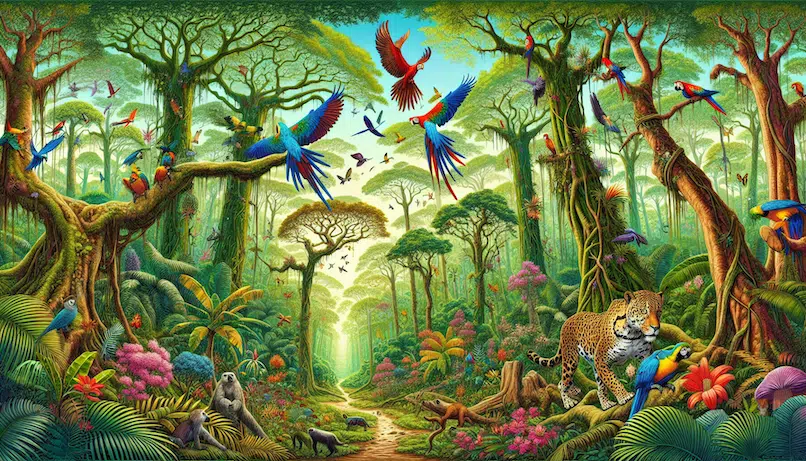

Amazon Wildlife
The Amazon Rainforest, also known as Amazonia, is unrivaled in its biodiversity. Covering roughly 5.5 million square kilometers, it harbors more than 3 million species of plants and animals, accounting for 10% of the world’s known species. The forest’s vast size and varied habitats support a remarkable range of life forms, making it a crucial biodiversity hotspot.
Within this lush environment, more than 400 billion individual trees contribute significantly to the ecosystem. The unique biodiversity of the Amazon is rooted not only in its species count but also in the complex interrelationships between species and their habitats.
We will delve into the various plant species, the abundance of animal species, and the significance of endemic species in this extraordinary environment.
Diversity of Amazonian Plant Species
The Amazon Rainforest is home to an astonishing variety of plant species. With over 390 billion individual trees, the canopy represents a complex, vibrant ecosystem. An estimated 16,000 tree species thrive in the Amazon, each playing a crucial role in maintaining the forest’s health and stability. Unique flora, including towering canopy trees, colorful orchids, and a diverse range of ferns, flourish in this rich environment.
These plants are not merely passive components of the ecosystem; they actively shape their surroundings. For instance, towering trees create microhabitats for numerous other species, while the vibrant orchids and ferns enhance the forest’s visual and ecological diversity. The plant life of the Amazon signifies the complexity and resilience of tropical rainforests.
Abundance of Animal Species
The Amazon Rainforest hosts an exceptionally diverse array of animal species. It is home to an estimated 2.5 million distinct insect species, making it one of the richest insect regions globally. Furthermore, around 1,300 bird species inhabit this forest, including iconic birds like macaws.
The diversity of animal life in the Amazon extends to mammals such as anacondas and jaguars, emblematic of the rainforest’s wild essence. The vast array of species, from minute insects to large predators, underscores the Amazon’s role as a critical refuge for wildlife. This diversity is vital for the ecological balance and overall health of the rainforest.
Endemic Species
The Amazon Rainforest is a sanctuary for endemic species, with approximately 2,000 species found nowhere else on the planet. This high level of endemism, representing about 2.5% of the Amazon’s species, highlights the unique evolutionary processes that have occurred in this isolated environment. Many of these species, including roughly 2,500 unique fish species in the Amazon River, are integral to the ecological structure of the rainforest.
Endemic species are particularly sensitive to habitat loss and environmental changes, making their conservation imperative. Protecting these unique organisms preserves biodiversity and maintains the ecological functions they perform. The endemic species of the Amazon underscore its evolutionary richness and the critical need for conservation.
Human Impact and Deforestation
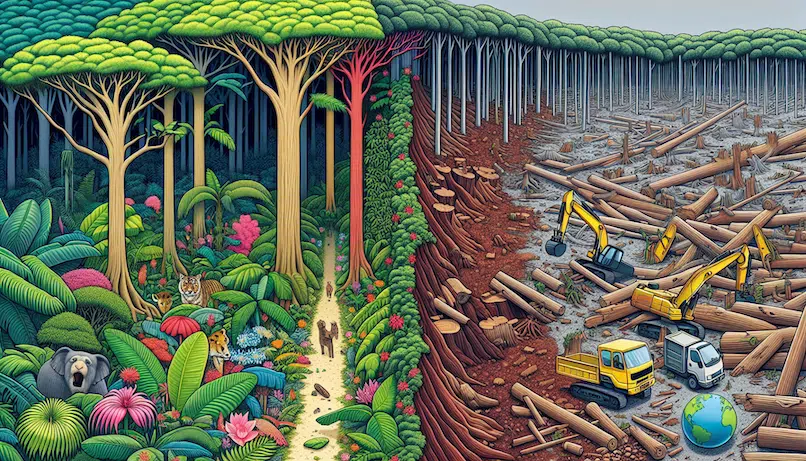

Deforestation Illustration
Human activities have dramatically affected the Amazon Rainforest, leading to extensive deforestation and habitat loss. The main drivers of deforestation include agricultural expansion, logging, and urbanization. Since the 1970s, approximately 1.4 million hectares of forest have been cleared, resulting in severe ecological consequences. Smoke from forest clearings and wildfires exacerbates the environmental crisis.
Despite efforts to reduce deforestation, the Amazon continues to face pressures from economic development and illegal activities. The relaxation of environmental regulations in 2008 and recent severe fire events highlight the ongoing challenges in conserving this vital ecosystem.
We will analyze the impacts of agricultural expansion, logging, and urbanization on the Amazon Rainforest.
Agricultural Expansion
Agricultural expansion, particularly for cattle ranching, is the leading cause of deforestation in the Amazon. Other contributing activities include mining, subsistence agriculture, and dam construction. Urban growth, agricultural fires, and timber plantations also play significant roles. The prevalent slash-and-burn farming method of the 1960s remains a substantial driver of forest loss.
The environmental ramifications of agricultural expansion are profound. Deforestation not only results in the loss of biodiversity but also exacerbates the greenhouse effect, contributing to global warming and climate change. The destruction of the forest cover disrupts the natural habitat, affecting countless species and altering local and global climate patterns.
Logging and Mining
Logging activities in the Amazon Rainforest significantly increase the likelihood of future deforestation in previously logged areas. Unsustainable and illegal logging practices contribute to forest degradation, diminishing the forest’s capacity to sequester carbon and support biodiversity. The extraction of valuable timber often initiates a cycle of destruction, where cleared areas become increasingly vulnerable to further deforestation.
Mining also poses a severe threat to the Amazon’s ecological integrity. The quest for mineral resources necessitates extensive land clearing, pollution, and habitat destruction. These activities not only degrade the environment but also undermine conservation efforts for the rainforest and its unique biodiversity.
Urbanization and Infrastructure Development
The construction of roads and highways has enhanced accessibility in the Amazon, facilitating human settlement and economic development. This increased access has led to further deforestation as more land becomes available for agricultural and industrial purposes. Urban expansion and infrastructure initiatives significantly impact the Amazon Rainforest’s environmental dynamics.
The growth of urban areas and infrastructure not only directly affects the forest but also influences local communities. The influx of people and the pressure of development can lead to conflicts over land use and resources, threatening the sustainability of traditional communities and conservation initiatives.
Balancing economic development with environmental conservation remains a crucial challenge for the Amazon region.
Conservation Efforts and Challenges
Conservation efforts for the Amazon Rainforest are multifaceted, involving both national and international policies, the participation of indigenous communities, and technological innovations. Recent collective initiatives involving eight Amazon Basin countries aim to establish a cohesive strategy to protect the rainforest. In 2023, the Brazilian Amazon saw a 50% reduction in deforestation compared to previous years, demonstrating the efficacy of coordinated conservation measures.
Despite these advancements, substantial challenges persist due to economic pressures and illegal activities. We will explore the various conservation strategies being implemented, the significant role of indigenous communities, and the innovative technologies being utilized to protect the Amazon Rainforest.
National and International Policies
National and international policies are critical to conserving Amazon forests. The Brazilian federal government aims to enforce a forest code that requires maintaining up to 80% of native vegetation on private lands. Additionally, Brazil aspires to achieve zero deforestation by 2030 as part of its climate initiatives, reflecting a strong commitment to environmental protection.
International support, such as the reactivation of the Amazon Fund, provides financial resources for conservation projects and sustainable practices within the rainforest. These policies and initiatives are essential for establishing a legal and financial framework that supports long-term conservation goals.
Role of Indigenous Communities
Indigenous communities are vital stewards of the Amazon Rainforest. Their traditional knowledge and sustainable practices are crucial in forest conservation. New conservation strategies are emphasizing the importance of securing indigenous land rights, which have proven effective in preventing fire incidents in the Amazon.
Indigenous cultures within the Amazon showcase rich traditions and a profound connection to their environment. Empowering these communities and acknowledging their rights are key elements for the success of conservation strategies.
Territories managed by indigenous peoples often exhibit significantly less degradation, emphasizing the importance of their involvement in safeguarding the rainforest.
Technological Innovations for Conservation
Technological advancements, especially in remote sensing technology, are vital for conservation initiatives in the Amazon Rainforest. This technology enhances understanding of the Amazon Basin and enables more informed decision-making regarding its protection. Remote sensing plays a crucial role in monitoring deforestation, allowing conservationists to track changes in the rainforest over time.
By providing real-time data on environmental changes, remote sensing improves the effectiveness of conservation efforts focused on preserving the Amazon. These technological tools are indispensable for comprehending the dynamics of the rainforest and implementing efficient conservation strategies.
The Amazon Rainforest and Global Climate Change
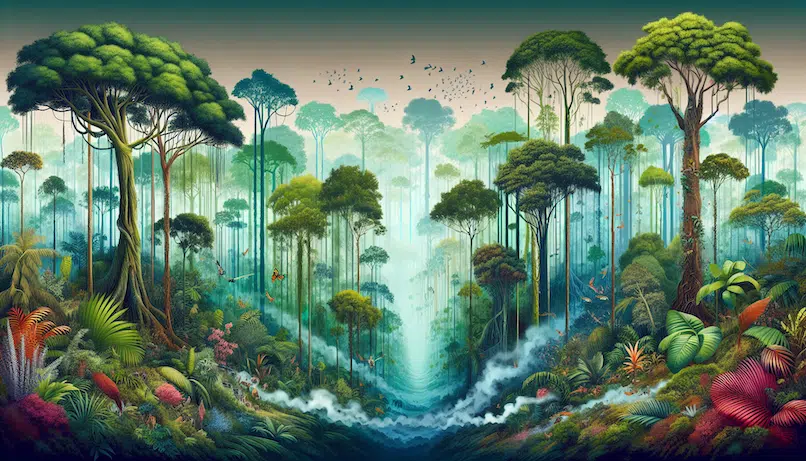

Global Climate Change
The Amazon Rainforest is integral to regulating the global climate due to its ability to absorb large volumes of carbon dioxide. The forest’s capacity to store nearly two years’ worth of global carbon emissions emphasizes its importance in combating climate change. Protecting the Amazon is crucial not only for its biodiversity but also for its role in carbon sequestration and climate control.
However, the ongoing destruction of the Amazon poses a significant risk, potentially transforming the forest from a carbon sink to a carbon source. We will explore the Amazon’s contributions to carbon sequestration, the implications of deforestation on global temperatures, and future projections based on climate change models.
Carbon Sequestration
It is estimated that the Amazon Rainforest stores over 100 billion metric tons of carbon within its biomass, making it a critical element in the global carbon cycle. As of 2022, trees in the Amazon contained 56.8 billion metric tons of carbon above ground, highlighting the forest’s immense carbon storage capacity. Indigenous territories, which exhibit significantly less degradation, play a vital role in preserving this carbon storage.
The Amazon Rainforest currently absorbs about 25% of the carbon dioxide captured by all terrestrial ecosystems on Earth. This capacity for carbon sequestration is essential for mitigating climate change effects and maintaining the balance of the global climate.
Effects of Deforestation on Global Temperatures
Deforestation has already led to the destruction of approximately 20% of the Amazon Rainforest. This loss can increase local temperatures by an average of 1 degree Celsius, with extreme temperatures rising by as much as 4.4 degrees Celsius. The temperature rise caused by deforestation not only influences local climates but also contributes to increasing global temperatures and climate instability.
The broader consequences of deforestation are profound. The Amazon’s vital role in climate regulation means that continued forest loss could significantly impact weather patterns, biodiversity, and the overall health of the planet. Tackling deforestation is essential for maintaining the Amazon as a stabilizing force within the global climate system.
Future Projections
Future projections according to climate change models indicate critical upcoming environmental changes in the Amazon Rainforest. The Belem Declaration urges immediate, transformative action to avert critical tipping points in the Amazon, underscoring the urgency for unified conservation efforts.
By the year 2050, climate models predict that significant portions of the Amazon region may transform into a dry savanna due to rising temperatures and altered precipitation patterns. Protecting the Amazon is not just about preserving its past but ensuring a sustainable future for the planet.
Recent Developments in the Amazon Rainforest
Recent events in the Amazon Rainforest reveal both the challenges and advancements in conservation endeavors. Human activities, such as deforestation and habitat erosion, now affect more than one-third of the region. Approximately 17% of the rainforest has been cleared due to human activity, emphasizing ongoing threats to this vital ecosystem.
Brazil’s President Lula has committed to reforesting 12 million hectares by 2030, building on commitments made during the 2015 Paris Agreement. These recent initiatives highlight the urgent need to address environmental incidents and implement effective policy changes to protect the Amazon Rainforest.
Current Deforestation Rates
Deforestation in the Amazon soared to 9,064 square kilometers from August 2022 to July 2023, an area roughly 40 percent larger than Delaware. By July 2024, deforestation rates had increased by 666 square kilometers compared to the previous year, indicating ongoing hardships in mitigating forest loss.
The variability in deforestation rates over time reflects the intricate interplay of economic, political, and environmental factors driving the clearing of forests. Addressing these challenges demands continuous cooperation among governments, NGOs, and local communities to develop and implement effective conservation strategies.
Significant Environmental Incidents
Significant environmental events, such as forest fires, have had a substantial impact on the Amazon Rainforest. In 2019, Brazil reported 72,843 fires, underscoring a concerning trend. These fires contribute to deforestation and jeopardize the biodiversity and ecological stability of the Amazon Rainforest.
The rising frequency and severity of forest fires signal the need for proactive measures to avert and mitigate their impact. Strengthening environmental regulations and advocating sustainable land management practices are crucial steps in shielding the Amazon from further degradation.
New Conservation Initiatives
Recent conservation initiatives are pivotal for the preservation and recovery of the Amazon Rainforest. Nonprofits and startups are increasingly focusing on projects to restore significant areas of the rainforest, promising to recover thousands of hectares by the decade’s end.
The successful execution of these projects could greatly contribute to the rejuvenation of the Amazon’s biodiversity and overall health. These initiatives represent a hopeful pathway forward, illustrating the potential of innovative solutions to address the complex challenges facing the Amazon.
Visual Exploration of the Amazon
Embark on a visual journey through the Amazon Rainforest, where breathtaking waterfalls, expansive rivers, and dense canopies weave together a captivating landscape. The Amazon is more than just a forest; it is a vibrant tapestry of ecosystems that encompasses lakes, rivers, and a towering rainforest canopy. Each facet of this landscape is crucial for the overall health and diversity of the rainforest.
The Amazon also plays an essential role in cooling the planet by releasing heat into the atmosphere, thereby aiding in the regulation of global temperatures. It stands as a critical component of Earth’s environmental systems, thanks to its ecological significance and stunning beauty.
Sustainable Ways to Explore the Rainforest
Now that you are aware of the Amazon Rainforest’s significance, there are sustainable options for those wishing to experience it firsthand while minimizing environmental impact. Opting for eco-friendly travel choices helps protect this delicate ecosystem while offering enriching experiences for visitors. GreenGo Travel, the largest wholesaler of sustainable rainforest tours globally, provides a range of responsible travel alternatives.
Recognized as Ecuador’s Leading Travel Agency for four consecutive years by the World Travel Awards, GreenGo Travel ensures that its tours support conservation initiatives and local communities.
We will explore sustainable lodgings and cruises that allow visitors to immerse themselves in the Amazon’s natural beauty while fostering conservation and sustainable development.
Amazon Rainforest Lodges
Staying at sustainable lodges like the Napo Wildlife Center, Sacha Lodge, and Sani Lodge offers an immersive experience in the Amazon Rainforest’s heart. These lodges prioritize environmental conservation and support local indigenous communities, providing guests with a chance to connect with nature and learn about the rainforest’s ecological importance.
Each lodge offers unique experiences, ranging from guided nature walks to wildlife spotting and cultural interactions with indigenous tribes. By selecting these eco-friendly accommodations, visitors contribute to the preservation of the Amazon and endorse sustainable tourism practices that benefit both the environment and local communities.
Amazon Rainforest Cruises
Amazon Rainforest cruises, such as the Anakonda and Manatee Cruises, provide an exceptional way to explore the river basin. These eco-conscious travel experiences allow guests to navigate the Amazon River while minimizing environmental footprints. Passengers can take in the breathtaking sights, encounter diverse wildlife, and gain insights about the rainforest’s ecological significance from knowledgeable guides.
Designed to promote conservation and sustainable tourism, these cruises ensure that visitors depart with an enriched understanding and appreciation of the Amazon Rainforest. By choosing sustainable travel alternatives, tourists can help safeguard this essential ecosystem for future generations.
Conclusion
The Amazon Rainforest is a vital pillar of Earth’s environmental systems, playing a crucial role in biodiversity conservation, climate regulation, and cultural heritage. From its extensive geographical reach and historical formation to its distinctive biodiversity and the substantial challenges it faces, the Amazon remains a focal point for conservation efforts. Safeguarding the Amazon is imperative not only for its ecological value but also for the planet’s overall well-being.
As we continue to confront the effects of deforestation, climate change, and human activities, it is essential to support sustainable development and conservation initiatives. By comprehending the complexities of the Amazon Rainforest and taking proactive measures to protect it, we can ensure that this invaluable natural treasure endures for future generations. Let us commit to the protection and restoration of the Amazon, drawing inspiration from its resilience and beauty.
Frequently Asked Questions
What countries does the Amazon Rainforest span?
The Amazon Rainforest stretches across nine countries: Brazil, Peru, Bolivia, Colombia, Venezuela, Guyana, Suriname, French Guiana, and Ecuador.
How much of the Amazon Rainforest is located in Brazil?
Approximately 58.4% of the Amazon Rainforest is situated in Brazil, emphasizing the country’s significant role in conserving this vital ecosystem.
What are the primary causes of deforestation in the Amazon?
Deforestation in the Amazon is primarily driven by agricultural expansion, logging, mining, and urbanization. Addressing these issues is crucial for safeguarding this essential ecosystem.
How does the Amazon Rainforest contribute to global climate regulation?
The Amazon Rainforest is instrumental in global climate regulation as it absorbs substantial amounts of carbon dioxide and stores over 100 billion metric tons of carbon in its biomass. This function helps mitigate climate change and maintain ecological balance.
What are some sustainable ways to visit the Amazon Rainforest?
For a sustainable visit to the Amazon Rainforest, consider staying in eco-friendly lodges like Napo Wildlife Center or Sacha Lodge, and embark on sustainable cruises such as Anakonda or Manatee Cruises. Such choices minimize environmental impact while supporting local conservation efforts.
Ready to embark on your Ecuador & Galapagos Adventure?
The Best Galapagos Search Engine on the Market!
Tailor and refine your Galapagos cruise options to suit your preferences and specific requests. With over 10 filters available, and more being added monthly, search for your ideal Ecuador & Galapagos tour today!
Discover Offers & Availability Now!



